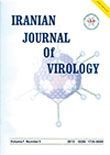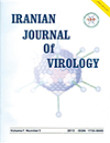فهرست مطالب

Iranian Journal of Virology
Volume:10 Issue: 4, 2016
- تاریخ انتشار: 1395/09/15
- تعداد عناوین: 6
-
-
Pages 1-11Background And AimsLumpy skin disease virus (LSDV), Goatpox virus and Sheeppox virus are members of genus Capripoxvirus of the Poxviridae, which have close genetic similarity. Therefore, the use of CaPV-vaccine strains derived from sheep and goat would be useful to protect cattle against LSD. The aim of This study was to compare the immune responses of two available CaPV vaccines against LSD in cattle.Materials And MethodsA total of 48 calves were vaccinated with Gorgan-Goat pox virus (GGPV) and RM/65-Sheep pox virus (RSPV) vaccines and humoral and cellular immunity were evaluated weekly.ResultsThe GGPV-vaccinated calves (GVC) had a higher levels of cellular immune responses measured, using DTH reaction at the vaccination site than RSPV-vaccinated calves (RVC), which indicated higher levels of immunogenicity produced by the GGPV-vaccine in cattle. Also, the serum Neutralization Index of vaccinated calves in response to vaccine strains (homologous virus) was higher than LSD virus (heterologous virus) in all time-point, although this difference in RVC was higher than GVC, and was significant in days 21 and 35 (pConclusionsThe results of this study indicated, that GGPV-vaccine had a good immunogenic response due to induction of high level of antibody titer and high lymphocyte proliferation and IFN-γ and IL-4 production. Therefore, it was considered suitable vaccine to control LSD.Keywords: Lumpy Skin Disease, Capri Pox Virus, Vaccine, Cellular, Humoral Immunity
-
Pages 12-17Background And AimsHepatitis E virus (HEV) infection is usually a self-limited viral disease that causes acute hepatitis and may progress to chronic hepatitis in immunosuppressed individuals. It seems that hemodialysis patients and HIV infected people are more exposed to HEV infection. The aim of this study was to evaluate the extent of HEV infection in hemodialysis and HIV infected patients in Iran using serological molecular methods.Materials And MethodsSerum and plasma samples were collected from 149 patients undergoing hemodialysis and also 102 proved HIV infected patients. Theses sera were used for detection of HEV total antibodies with Enzyme immunoassay and HEV RNA by Real Time PCR. Demographic and clinical data were obtained and analyzed by SPSS version 16.ResultsHEV antibody for hemodialysis patients and HIV infected individuals were (4%) and (33.3%) respectively. No viremia was observed in both HIV and hemodialysis serum samples. There was no association between demographic and clinical data and HEV antibody positive people.ConclusionsThis study showed some different results in comparison with other studies in Iran. These conflicting results showed differences between HEV infection in hemodialysis and HIV-infected patients in Iran.Keywords: Hepatitis E HIV_Hemodialysis_serology_viremia
-
Pages 18-25Background And AimsAvian infectious bronchitis (IB) has prevalent in the most chicken farms during recent years, in spite of the IB vaccination program which has been widely performed in Iran. To better understand the molecular epidemiology of IBV in Iran, the full length sequences of S1 gene of Iranian QX IBVs were determined and phylogenetic analysis was done using some sequences of IBV.Materials And MethodsTo better understand the molecular epidemiology of IBV in Iran, the full length sequences of S1 gene of Iranian QX IBVs were determined and phylogenetic analysis was done using some sequences of IBV.ResultsIranian QX IBVs were located in LX4 (Cluster 2). The nucleotides homologies were 99.52% - 100% between the isolates. Phylogenetic analysis revealed that all the IBV isolates were very similar and probably had a common origin. The hyperactive variable regions of S1 were determined.ConclusionsThe results from this study and other published results in the GenBank database showed that the isolates circulating in Iran in recent years were mainly LX4 (Cluster 2) genotype, which is the predominant genotype circulating in Iran in recent years (After first report of QX IBV in Iran, 2011). This finding provides important information on IBV evolution in Iran.Keywords: Avian Infectious Bronchitis, QX, Iran, Phylogenetic analysis, Spike
-
Pages 26-33Background And AimsWild-type RS-12 strain of mumps virus has been isolated from an Iranian patient and has been attenuated after several serial passages. This study was designed to determine nucleotide and amino acid substitutions in the HN, F and SH genes during attenuation of the wild-type virus.Materials And MethodsRequired viral samples prepared at Razi Vaccine and Serum Institute. Viral RNA was extracted, targeted segments were amplified and sequenced and finally were analyzed using DNAMAN software.ResultsNo difference in nucleotide and deduced amino acid sequence of the F and SH genes was detected following attenuation of wild-type as compared to the vaccine strain, but four nucleotide changes in HN gene had occurred which had resulted in two nucleotide differences.ConclusionsConsidering the HN nucleotide sequences and the deduced amino acid sequences, RS-12 wild-type and vaccine strains were distinguishable. Moreover, unique differences between RS-12 and some other vaccine strains existed. During serial passages of RS-12 strain for seed lot system preparation, no change in HN, F and SH genes occurred which -at least in some extents- proved the genetic stability of the attenuated RS-12 surface proteins. Potential attenuating mutations in other genes (N, P, M, L and even non-coding regions in 3′ and 5′ ends) should be investigated and confirmed using advanced methods.Keywords: RS-12, mumps virus, vaccine
-
Evaluation of Quality of Two Commercial Oil-Emulsion Newcastle Disease Vaccines In-vivo and In-vitroPages 34-38Background And AimsNewcastle disease (ND) is a highly contagious disease in poultry with economic losses in the world. Vaccination is one of the most important ways for prevention and control of NDV, but there are reports of ND outbreaks in vaccinated chickens. Poor quality of the vaccines is one of the reasons of vaccine failure. In this study the quality of two commercial oil-emulsion Newcastle disease virus (OE-NDV) vaccines was evaluated in in-vitro and in-vivo.Materials And MethodsFor in-vitro study, the amount of total protein and quantity of retrieved hemagglutination activity (HA) of the vaccines were recovered and measured, then, the amount of recovered total protein and retrieved HA were compared with the serologic responses induced in chickens by each vaccine(in-vivo study).ResultsThe results showed that the extracted total protein , recovered HA titer, and Mean HI titers to vaccine A are higher than vaccine B.The results also indicated that there is a good correlation between retrieved HA activity, extracted total protein and antibody response to vaccine A, but about vaccine B, there is no good correlation between total protein and retrieved HA activity and antibody response.ConclusionsQuality of Vaccine B is lower than vaccine A, likely because of many reasons particularly improper storage of the vaccine, inappropriate harvesting of egg allantoic fluid and inactivation of NDV.Keywords: Hemagglutination activity, Total protein, vaccine potency, Hemagglutination inhibition
-
Pages 39-40Dengue fever is a mosquito-borne infection which is endemic in Southeast Asia. Although it has not been distributed in Iran, locating near other countries where the Dengue has been revealed is a threat for Iran because different connection between countries may increase the rate of infection.Keywords: Dengue Viruses, Flaviviridae, Aedes, Iran


